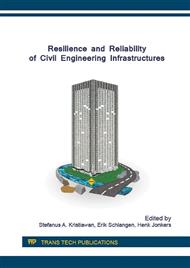[1]
TC4-ISSMGE, Manual for Zonation on Seismic Geotechnical Hazard Revised edition, Technical Committee for Earthquake Geotechnical Engineering (TC4) of the International Society of Soil Mechanics and Geotechnical Engineering (ISSMGE) (1999) p.209.
DOI: 10.1201/noe0415804844
Google Scholar
[2]
Sitharam, T.G., Anbazhagan, P., Seismic Microzonation: Principles, Practices and Experiments, Electric Journal of Geotechnical Engineering, (2008).
Google Scholar
[3]
Kementerian Pekerjaan Umum, Tata cara perencanaan ketahanan gempa untuk struktur bangunan gedung dan non gedung, (2012), SNI-1726-(2012).
DOI: 10.25139/jprs.v1i1.799
Google Scholar
[4]
Kramer, S.L. Geotechnical Earthquake Engineering. USA : Prentice-Hall Inc. (1996).
Google Scholar
[5]
Crouse, C. B. Ground-motion attenuation equation for earthquake on Cascadia subduction-zone earthquake, Earthq. Spectra 7, 210–236. (1991).
DOI: 10.1193/1.1585626
Google Scholar
[6]
Donovan, N.C., Bornstein, A.E., Uncertainties in seismic risk analysis. Journal of The Geotechnical Engineering Division, ASCE, 104(GT7): 869–887, (Jul 1978).
DOI: 10.1061/ajgeb6.0000669
Google Scholar
[7]
Boore, D. M., W. B. Joyner, and T. E. Fumal, Equations for estimating horizontal response spectra and peak acceleration from western North American earthquakes: A summary of recent work, Seismological Research Letters, 68(1), 128-153. (1997).
DOI: 10.1785/gssrl.68.1.128
Google Scholar
[8]
Fukushima, Y., and T. Tanaka. A new attenuation relation for peak horizontal acceleration of strong earthquake ground motion in Japan, Bull. Seismol. Soc. Am. 80, 757–783. (1990).
Google Scholar
[9]
Mayne, P.,W. In situ test calibrations for evaluating soil parameters. Proc., Characterization and Engineering Properties of Natural Soils II, Singapore. (2006).
DOI: 10.1201/noe0415426916.ch2
Google Scholar
[10]
Mayne, P. W., Peuchen, J., & Bouwmeester, D. Soil unit weight estimation from CPTs. Paper presented at the 2nd International Symposium on Cone Penetration Testing. (2010).
Google Scholar
[11]
Wair, B.R., De-Jong, J. T., Shantz, T. Guidelines for Estimation of Shear Wave Velocity Profiles. PEER Report-Pacific Earthquake Engineering Research Centre. (2012).
Google Scholar
[12]
Bardet, J. P., Ichii, K., & Lin, C. H. EERA a computer program for Equivalent- linear Earthquake site Response Analyses of layered soil deposits: Department of Civil Engineering, University of Southern California. (2000).
Google Scholar
[13]
Schnabel, P. B., Lysmer, J., & Seed, H. B. A computer program for earthquake response analysis of horizontally layered sites, Earthqukae Engineering Research Center EERC Report 72-12. Berkeley, California: University of California. (1972).
Google Scholar
[14]
Idriss, I. M., & Sun, J. I. User's manual for SHAKE91. Davis, California: Center for Geotechnical Modeling, Department of Civil & Environmental Engineering, University of California. (1992).
Google Scholar
[15]
Seed, H. B., & Idriss, I. M. Simplified procedure for evaluating soil liquefaction potential. Journal of the Soil Mechanics and Foundations Division, ASCE, Vol. 97(No. SM9), 25. (1971).
DOI: 10.1061/jsfeaq.0001662
Google Scholar
[16]
Idriss, I. M., & Sun, J. I. User's manual for SHAKE91. Davis, California: Center for Geotechnical Modeling, Department of Civil & Environmental Engineering, University of California. (1992).
Google Scholar
[17]
Schnabel, P. B., Lysmer, J., & Seed, H. B. A computer program for earthquake response analysis of horizontally layered sites, Earthqukae Engineering Research Center EERC Report 72-12. Berkeley, California: University of California. (1972).
Google Scholar
[18]
Setiawan, B. Assessing liquefaction potential of soils utilising in-situ testing. M. Eng. Sc Thesis. The University of Adelaide South Australia. (2011).
Google Scholar


